
Maastricht silver is a collective name for silver objects produced in Maastricht, Netherlands, mainly in the 17th and 18th centuries, when the town was a major centre for silversmithing.

Maastricht silver is a collective name for silver objects produced in Maastricht, Netherlands, mainly in the 17th and 18th centuries, when the town was a major centre for silversmithing.
In Maastricht, from the 16th century until the early 19th century a considerable number of silversmiths were active. [1] They were united in the guild of Saint Eligius, which via the apprentice tradition controlled the transmission of tools and techniques from generation to generation. [2] The silver-working guild checked each piece of silver before it was stamped with three silver hallmarks: The city hallmark, a five-pointed star, indicated the quality of the silver guaranteed by the town of Maastricht. A second hallmark, the year letter, indicated the bi-annual period it was made in. The third hallmark was the mark of the silversmith.
The oldest known piece stamped with the Maastricht hallmark is the so-called arm of Saint Thomas , a 15th-century silver reliquary in the shape of an arm, now in the Treasury of the Basilica of Saint Servatius in Maastricht. [3] Unfortunately, very little is left from this period. After the Siege of Maastricht (1579) the Spanish troops ransacked the city for three days and took anything made of gold or silver. [4] Some silver chalices and monstrances from the 17th century have survived. With the arrival of the French revolutionary troops in 1794, the medieval trade system was discarded of and the guild of Saint Eligius dissolved.
The Museum aan het Vrijthof in Maastricht has the most comprehensive collection of Maastricht silver, although not nearly as complete as one would like to see. However, here one is able to discern the development of the craftsmanship throughout the various Louis styles of the 18th century. In 2012, the recently re-opened museum staged an exhibition of Maastricht silver.
The Bonnefanten Museum and the treasuries of the Basilica of Our Lady and the Basilica of Saint Servatius, all in Maastricht, as well as a number of museums, churches and private collectors in the Netherlands and around the world, own pieces of Maastricht silver. [5]
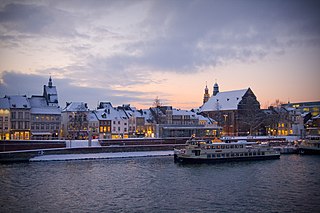
Maastricht is a city and a municipality in the southeastern Netherlands. It is the capital and largest city of the province of Limburg. Maastricht is located on both sides of the Meuse, at the point where the river is joined by the Jeker. Mount Saint Peter (Sint-Pietersberg) is largely situated within the city's municipal borders. Maastricht is adjacent to the border with Belgium and is part of the Meuse-Rhine Euroregion, an international metropolis with a population of about 3.9 million, which includes the nearby German and Belgian cities of Aachen, Liège, and Hasselt.

Tongeren is a city and municipality located in the Belgian province of Limburg, in the southeastern corner of the Flemish region of Belgium. Tongeren is the oldest town in Belgium, as the only Roman administrative capital within the country's borders. As a Roman city, it was inhabited by the Tungri, and known as Atuatuca Tungrorum, it was the administrative centre of the Civitas Tungrorum district.

The Bonnefanten Museum is a museum of fine art in Maastricht, Netherlands.
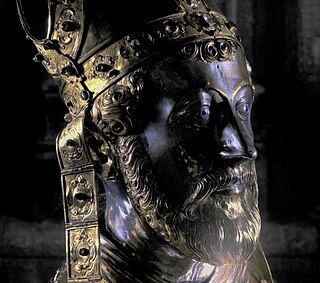
Saint Servatius was bishop of Tongeren. Servatius is patron saint of the city of Maastricht and the towns of Schijndel and Grimbergen. He is one of the Ice Saints. His feast day is May 13.
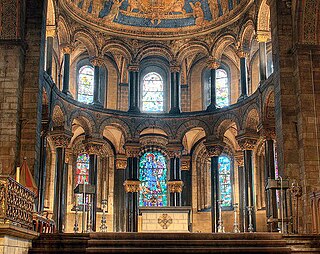
Mosan art is a regional style of art from the valley of the Meuse in present-day Belgium, the Netherlands, and Germany. Although in a broader sense the term applies to art from this region from all periods, it generally refers to Romanesque art, with Mosan Romanesque architecture, stone carving, metalwork, enamelling and manuscript illumination reaching a high level of development during the 11th, 12th and 13th centuries.

The Curtius Museum is a museum of archaeology and decorative arts located on the bank of the river Meuse in Liège, Belgium. It is classified as a Major Heritage of Wallonia.

The Basilica of Saint Servatius is a Roman Catholic church dedicated to Saint Servatius, in the center of Maastricht, Netherlands. The architecturally hybrid but mainly Romanesque church is situated next to the Gothic Church of Saint John, backing onto the town's main square, Vrijthof.
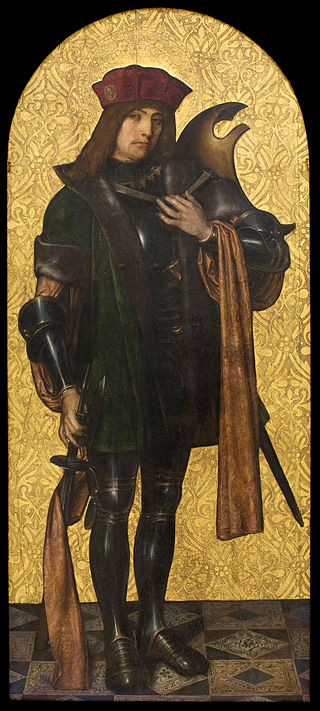
Candidus was a commander of the Theban Legion. The Theban Legion was composed of Christians from Upper Egypt. He is venerated as a Christian saint and martyr.
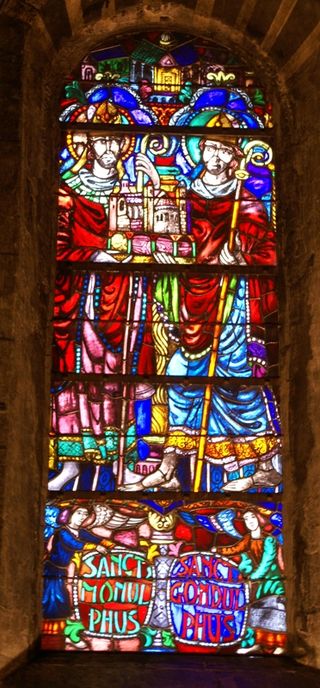
Monulph was a sixth-century bishop of Tongeren and Maastricht, and is revered as a Roman Catholic saint.
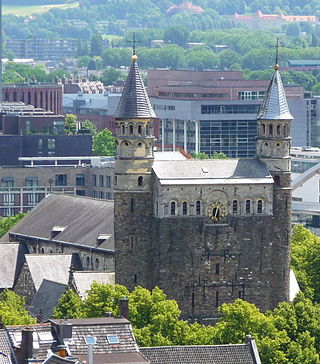
The Basilica of Our Lady is a Romanesque church in the historic center of Maastricht, Netherlands. The church is dedicated to Our Lady of the Assumption and is a Roman Catholic parish church in the Diocese of Roermond. The church is often referred to as the Star of the Sea, after the church's main devotion, Our Lady, Star of the Sea.

The Fotomuseum aan het Vrijthof is a museum of photography in Maastricht, Netherlands.

The Treasury of the Basilica of Saint Servatius is a museum of religious art and artifacts inside the Basilica of Saint Servatius in Maastricht, Netherlands.

Binnenstad is a neighbourhood in Maastricht, Netherlands. Until 2007, it was officially named City. As its name suggests, it is the most centrally located area of Maastricht.

A church treasury or church treasure is the collection of historical art treasures belonging to a church, usually a cathedral or monastery. Such "treasure" is usually held and displayed in the church's treasury or in a diocesan museum. Historically the highlight of church treasures was often a collection of reliquaries.
The following is a timeline of the history of the municipality of Maastricht, Netherlands.
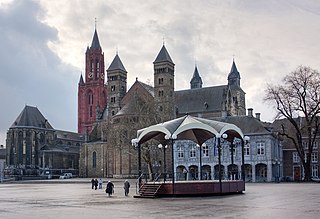
Vrijthof is a large urban square in the centre of Maastricht, Netherlands. The square developed from an ancient Roman and Frankish cemetery into a semi-private space that belonged to the Collegiate Church of Saint Servatius. In the 19th century, it became the town's main square. It is surrounded by important heritage buildings, museums, a theatre, and a range of hotels, restaurants, and bars. The square is regularly used for public events.

The Trier Cathedral Treasury is a museum of Christian art and medieval art in Trier, Germany. The museum is owned by the Roman Catholic Diocese of Trier and is located inside the Cathedral of Trier. It contains some of the church's most valuable relics, reliquaries, liturgical vessels, ivories, manuscripts and other artistic objects. The history of the Trier church treasure goes back at least 800 years. In spite of heavy losses during the period of the Coalition Wars, it is one of the richest cathedral treasuries in Germany. With the cathedral it forms part of a UNESCO World Heritage Site.

The Pilgrimage of the Relics or Maastricht Septennial Pilgrimage is a seven-yearly Catholic event in the Dutch city of Maastricht. Originating in the Middle Ages, it developed from a pilgrimage to the grave of Saint Servatius into the present-day religious, historical, cultural and commercial enterprise. Highlights in the programme are the displaying or unveiling of the relics in the main churches and secondly, the processions with the town's main relics. The next pilgrimage will take place in 2025.

The Ansembourg Museum is a museum in the Belgian city of Liège. It is housed in the hôtel d'Ansembourg on Féronstrée in the historic heart of the city.

The Sint-Janskerk is a Gothic church in the center of Maastricht, Netherlands. The Protestant Sint-Jan is situated next to the Roman Catholic Basilica of Saint Servatius on the town's main square, Vrijthof.